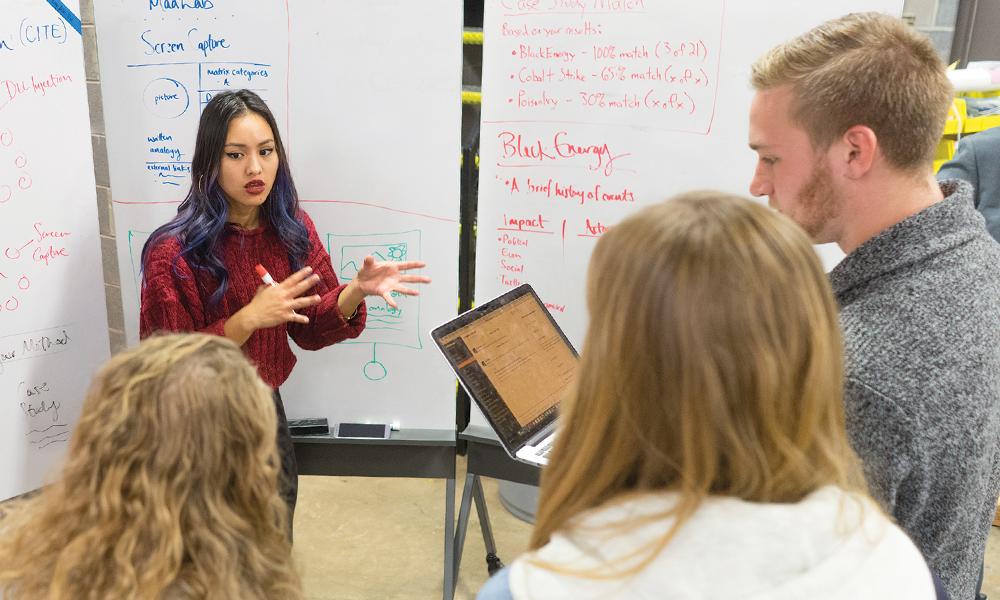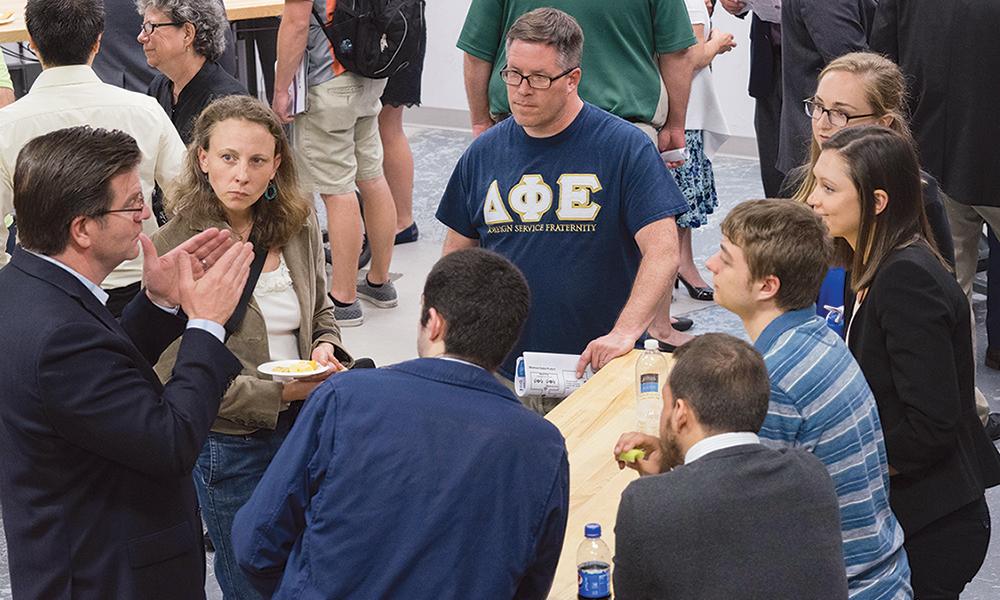Hacking for Diplomacy
Students bring fresh perspective to ‘wicked’ problems facing government and industry
Science and Technology
SUMMARY: The students were assigned to one of five teams, each representing a real-world client, and tasked with coming up with what H4Di terms a “minimal viable product.” Over the course of the semester, the students gained unprecedented knowledge and experience, and honed their skills in civil discourse and meaningful problem solving.
from the Spring-Summer 2018 issue of Madison
By Kim Fisher
How can students learn the skills they need to provide effective, meaningful solutions to complex problems in a global arena characterized by disparate needs and opinions?
Enter Hacking For Diplomacy, a course designed by Stanford University in which multidisciplinary teams of students work on real-world, “wicked” problems provided by sponsor organizations. H4Di uses innovative research methods to help students unravel these problems, which defy easy solutions.
In 2017, JMU offered the only H4Di course in the country at JMU X-Labs and was the first in the nation to offer it exclusively to undergraduate students.
 |
| Kirsten San Nicolas (with marker in hand), Luke Robb (with laptop) and fellow undergraduate students employ meaningful problem-solving skills to outline potential solutions to a complex issue. |
Students representing nine different majors at JMU—economics, engineering, English, intelligence analysis, international affairs, communication studies, public policy, sociology, and writing, rhetoric and technical communication—came together in Fall 2017 to work with H4Di clients in government and industry. That meant being open to new ideas and unfamiliar strategies.
“It’s easy to work with people in your major because you all have the same mindset,” said Luke Robb, a junior double majoring in public policy and administration and communication studies. “In this class, we had to come together with our different mindsets and different approaches to find a middle ground and an understanding toward a meaningful solution."
|
'It’s easy to work with people in your major because you all have the same mindset. In this class, we had to come together with our different mindsets and different approaches to find a middle ground and an understanding toward a meaningful solution.' — Luke Robb, junior double majoring in public policy and administration and communication studies |
The unorthodox class also challenged the professors, who hailed from WRTC, political science, engineering and communication studies. Not only were the faculty members working across disciplines themselves, they also had to relinquish the convention that the instructor should be the expert. Instead, they took on the roles of coach, mentor or guide, depending on what the students needed as they researched their problems.
"The students get caught up in the problem and they think they’re stuck. But they're actually at a tipping point of realizing their full potential,” said Jennifer PeeksMease, a professor of communication studies. “Our job is to push them past that tipping point so they recognize they’re capable of much more than they had imagined.”
Using H4Di’s Lean Startup methodology, the students were steeped in intensive hands-on learning. Every week, after exhaustively interviewing sponsors and other industry, government and university experts, the teams presented their findings to the rest of the class and adapted their approaches as they deepened their understanding of the problems and potential solutions.
 |
| Professor Jennifer PeeksMease (second from left) listens with a student group as an industry participant explains a real-world problem. |
“They’re talking to all sorts of people in one area, building a network of professors and business experts, which opens doors for them and their clients that they didn’t even know existed,” said Seán McCarthy, a professor of writing, rhetoric and technical communication. “And by looking at these virtually unresolvable problems with fresh eyes, at the very least they’re going to provide a paradigm shift of how these companies are looking at a problem.”
The students were assigned to one of five teams, each representing a client, and tasked with coming up with what H4Di terms a “minimal viable product.”
The Aspen Institute, a nonpartisan think-tank, asked students to come up with solutions to the problem of widespread financial insecurity. “Our field desperately needs new, outside-the-box ideas for solving the many financial problems ailing Americans—like income volatility, consumer debt, and lack of retirement savings,” said senior program manager David Mitchell. “The more smart, young people we have thinking about these wicked problems, the better.”
Another client, the cybersecurity firm Endgame, challenged a team of five students with “closing the knowledge gap between cybersecurity experts and policymakers by focusing on all-source intelligence analysts and their need to understand cyber threats.” Over the course of the semester, the team developed an open-source, online tool called Cyber Information Technology Education, which decodes an existing matrix of information on more than 200 types of cyber tactics and techniques. By itself, the matrix is intelligible only to those with training in cybersecurity, making it inaccessible to many policy and intelligence professionals. Using clear analogies and case studies that complement the matrix, CITE provides a baseline of knowledge for all-source intelligence analysts.
On another project, charged six students with developing a way to monitor information warfare on various social media platforms in North Africa. The project entailed an early warning detection system that tracks social movements from beginning to end using trigger words and social media analytics to develop counter-messages. After several major pivots during the research and interview phases, the students landed on three deliverables: a partnership to help track/gather social media data, a threat escalation model and an explanation of bots and their capabilities.
|
'They’re talking to all sorts of people in one area, building a network of professors and business experts, which opens doors for them and their clients that they didn’t even know existed.' — Seán McCarthy, professor of writing, rhetoric and technical communication |
Over the course of the semester, the students gained unprecedented knowledge and experience, and honed their skills in civil discourse and meaningful problem solving.
“This class really tests your ability and helps you learn how to apply your skills,” said Kirsten San Nicolas, a senior double majoring in international affairs and economics. “Everyone has brought something from their major to make this project work.”
The project also had a profound impact on the clients.
“[I saw them] rapidly becoming professionals,” one sponsor said. “From our first interview, you could tell they were uncomfortable and struggling a little bit to learn about the problem. By the end, it was as if they were junior executives presenting an actual product that could actually be used in a real-life application.”
###
Editor’s Note: Hacking for Diplomacy is part of a suite of Stanford-designed courses that include Hacking for Defense. Among the challenges H4D students at JMU were tasked with this spring was improving air travel security for the Department of Homeland Security. Specifically, the H4D team looked for innovative approaches that will enable the Transportation Security Administration to be able to associate passengers with their personal belongings, helping lines move faster and reducing theft and lost items at checkpoints.
